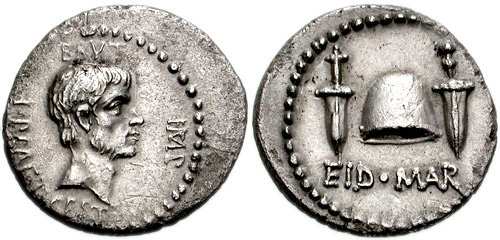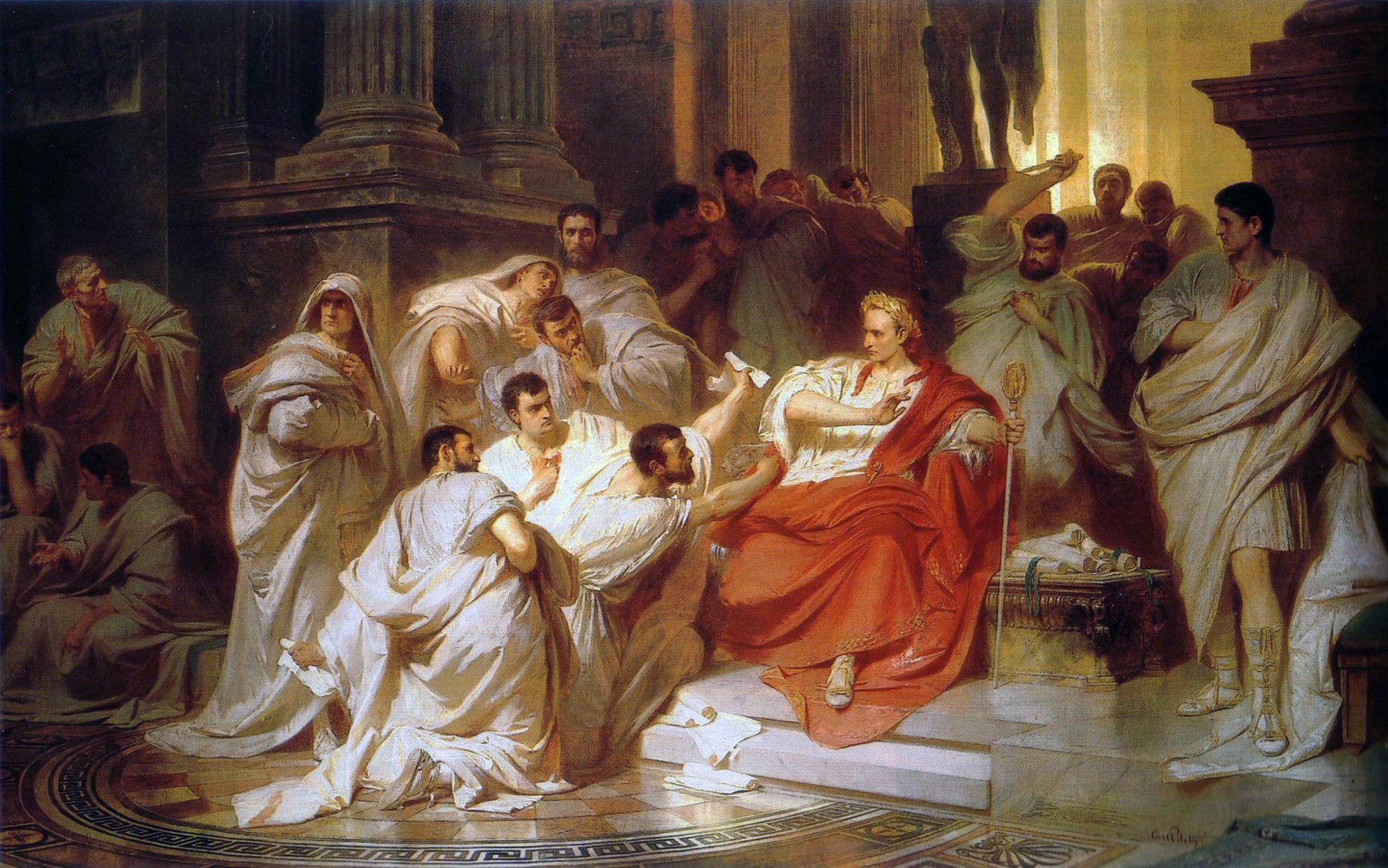|
The Murder Of Caesar (Piloty)
''The Murder of Caesar'' is a 1865 painting by Karl von Piloty which depicts the assassination of Julius Caesar. Description The painting positions Caesar seated, crowned, and robed in a scarlet toga, as the centre and focus of composition. Tillius Cimber is depicted pulling on Caesar's toga to both distract and pin him, as Servilius Casca Publius Servilius Casca Longus (died c. 42 BC) was one of the assassins of Julius Caesar. He and several other senators conspired to kill him, a plan which they carried out on 15 March, 44 BC. Afterwards, Casca fought with the liberators dur ... sneaks behind Caesar and attempts to stab Caesar with a dagger. Reception '' The Contemporary Review'' described the paintings as "a highly realistic, dramatic, not to say sporadic, composition". "Pitloy paints for effect, his art indeed would be artificial were it not empathetically real. The perfecting of a sensational style has been with him for a life study." '' The Art Journal'' stated that i ... [...More Info...] [...Related Items...] OR: [Wikipedia] [Google] [Baidu] |
Karl Von Piloty
Karl Theodor von Piloty (1 October 1826 – 21 July 1886) was a German painter, noted for his historical subjects, and recognised as the foremost representative of the realistic school in Germany. Life and work Piloty was born in Munich. His father, Ferdinand Piloty (d. 1844), enjoyed a great reputation as a lithographer. In 1840, Karl was admitted as a student of the Munich Academy, under the artists Karl Schorn and Julius Schnorr von Karolsfeld. A year later the acclaimed history paintings (referred to as the 'Belgian paintings'), i.e. the '' Compromise of the nobles'' and ''The Abdication of Charles V'' by the two Belgian artists Edouard de Bièfve and Louis Gallait, were shown in Munich and their realistic depiction of a historic subject matter made a lasting impression on him. After a journey to Belgium, France and England, Piloty commenced work as a painter of genre pictures, and in 1853 produced a work, ''Die Amme'' (''The Wet Nurse''), which, on account of its origina ... [...More Info...] [...Related Items...] OR: [Wikipedia] [Google] [Baidu] |
Assassination Of Julius Caesar
Julius Caesar, the Roman dictator, was assassinated by a group of senators on the Ides of March (15 March) of 44 BC during a meeting of the Senate at the Curia of Pompey of the Theatre of Pompey in Rome where the senators stabbed Caesar 23 times. They claimed to be acting over fears that Caesar's unprecedented concentration of power during his dictatorship was undermining the Roman Republic. At least 60 senators were party to the conspiracy, led by Marcus Junius Brutus and Gaius Cassius Longinus. Despite the death of Caesar, the conspirators were unable to restore the institutions of the Republic. The ramifications of the assassination led to the Liberators' civil war and ultimately to the Principate period of the Roman Empire. Causes Caesar had served the Republic for eight years in the Gallic Wars, fully conquering the region of Gaul (roughly equivalent to modern-day France). After the Roman Senate demanded Caesar to disband his army and return home as a civilian, he ref ... [...More Info...] [...Related Items...] OR: [Wikipedia] [Google] [Baidu] |
Tillius Cimber
Lucius Tillius Cimber (died 42 BC) was a Roman senator. He was one of the assassins of Julius Caesar, creating the diversion that enabled the conspirators to attack. Assassin Cimber was initially one of Caesar's strongest supporters. Caesar granted Cimber governorship of the provinces of Bithynia and Pontus in 44 BC. He may also have been Praetor in the same year.Mark Toher, "Tillius and Horace", ''Classical Quarterly'', 55.1, 2005, pp.183–189 Cicero once used Cimber's influence on Caesar to help a friend. It is not known why he joined the assassination, but Seneca states that he was motivated by ambition. His role was to set the stage for the attack by presenting to Caesar a petition to recall Cimber's exiled brother Publius. Plutarch states that other assassins then pretended to add their own petitions to Cimber's. According to Suetonius, Caesar gestured him away, but Cimber grabbed hold of him by the shoulders and pulled down Caesar's tunic. Caesar then cried to Cimber "Why, ... [...More Info...] [...Related Items...] OR: [Wikipedia] [Google] [Baidu] |
Servilius Casca
Publius Servilius Casca Longus (died c. 42 BC) was one of the assassins of Julius Caesar. He and several other senators conspired to kill him, a plan which they carried out on 15 March, 44 BC. Afterwards, Casca fought with the liberators during the Liberators' civil war. He is believed to have died by suicide after their defeat at the Battle of Philippi in 42 BC. Life Despite his being initially a childhood friend of Caesar, Casca and his brother Titedius joined in the assassination. Casca struck the first blow, attacking Caesar from behind and hitting his bare shoulders, after Tillius Cimber had distracted the dictator by grabbing his toga. Caesar replied "Casca, you villain, what are you doing?" and tussled with him for several seconds. Casca simultaneously shouted to his brother in Greek, "Brother, help me!" The other assassins then joined in. At the time Casca held the office of tribune of the plebs. After the assassination he fled Rome, and his colleague in the tribunat ... [...More Info...] [...Related Items...] OR: [Wikipedia] [Google] [Baidu] |
The Contemporary Review
''The Contemporary Review'' is a British biannual, formerly quarterly, magazine. It has an uncertain future as of 2013. History The magazine was established in 1866 by Alexander Strahan and a group of intellectuals anxious to promote intelligent and independent opinion about the great issues of their day. They intended it to be the church-minded counterpart and in May 1877 published an article on the "Ethics of Belief" from a distinguished Cambridge don on moral skepticism in law and philosophy. Prof Clifford developed scientific theories on metaphysical beliefs, rationalism, and the empirical value of scientific enquiry that underpinned advanced physics. By the end of the century his views had a practicable impact upon new social realism. Clifford was quickly rebutted by Prof Wase in June 1877. Articles by Rev R.F. Littledale, a regular contributor included "Christianity and Patriotism".Contemporary Review (1877), vol. 30, contents This contrasted to the radical artistic ... [...More Info...] [...Related Items...] OR: [Wikipedia] [Google] [Baidu] |
The Art Journal
''The Art Journal'' was the most important British 19th-century magazine on art. It was founded in 1839 by Hodgson & Graves, print publishers, 6 Pall Mall, with the title ''Art Union Monthly Journal'' (or ''The Art Union''), the first issue of 750 copies appearing 15 February 1839. It was published in London but its readership was global in reach. History Hodgson & Graves hired Samuel Carter Hall as editor of ''Art Union Monthly Journal'', assisted by James Dafforne. Hall soon became the principal proprietor, but he was unable to turn a profit on his own. The London publisher George Virtue bought a share of the business in 1848, with Hall remaining as editor, and they renamed the periodical ''The Art Journal'' in 1849. In 1851, as part of the "Great Exhibition" of that year, ''The Art Journal'' featured Hall's engravings of 150 pictures from the private collections of Queen Victoria and Prince Albert. Although this project was popular, the publication remained unprofitable, f ... [...More Info...] [...Related Items...] OR: [Wikipedia] [Google] [Baidu] |
Paintings Of The Death Of Julius Caesar
Painting is the practice of applying paint, pigment, color or other medium to a solid surface (called the "matrix" or "support"). The medium is commonly applied to the base with a brush, but other implements, such as knives, sponges, and airbrushes, can be used. In art, the term ''painting ''describes both the act and the result of the action (the final work is called "a painting"). The support for paintings includes such surfaces as walls, paper, canvas, wood, glass, lacquer, pottery, leaf, copper and concrete, and the painting may incorporate multiple other materials, including sand, clay, paper, plaster, gold leaf, and even whole objects. Painting is an important form in the visual arts, bringing in elements such as drawing, composition, gesture (as in gestural painting), narration (as in narrative art), and abstraction (as in abstract art). Paintings can be naturalistic and representational (as in still life and landscape painting), photographic, abstract, narrati ... [...More Info...] [...Related Items...] OR: [Wikipedia] [Google] [Baidu] |




